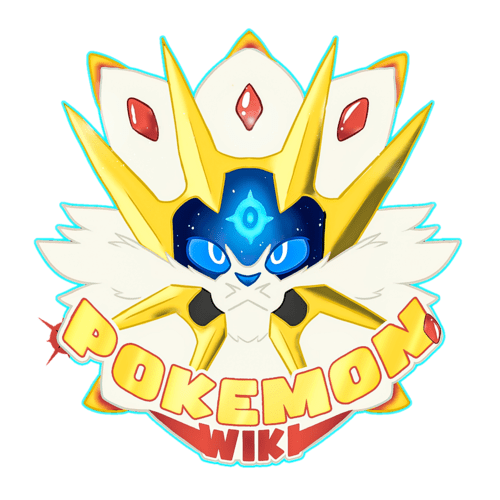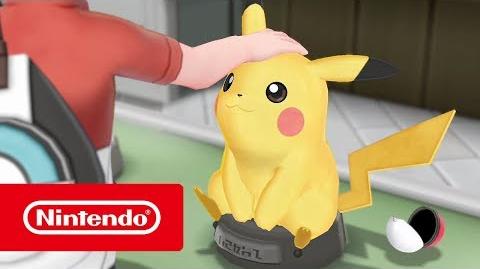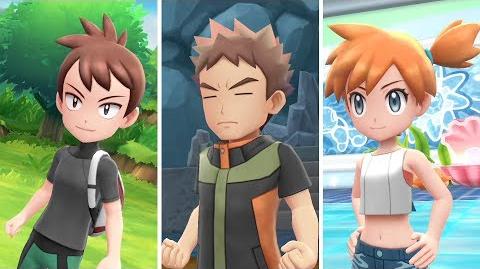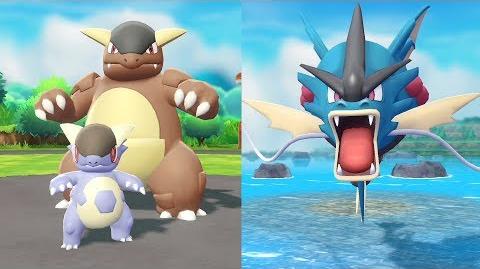Template:Infobox Game Pokémon Let's Go Pikachu and Pokémon Let's Go Eevee (ポケットモンスター Let's Go! ピカチュウ・Let’s Go! イーブイ Poketto Monsutaa Rettsu Go Pikachuu & Rettsu Go Iibui) are two games of Generation VII set in the Kanto region.
Audience
The games have a much more specific target audience than previous main series games. They are targeted towards younger players, people who are only familiar with the popular side-series game Pokémon GO, people who are only familiar with the anime, and those who have not played since the original generation of games.
New features
- The player can customize their character, and the appearance of Pikachu or Eevee. While Pikachu, Eevee, and the player character can change into matching outfits, customization of the Pokémon also includes things such as gender and hairstyles.
- Female Eevee now have a heart-shaped pattern on the tip of their tails, similar to the heart-shaped tails of female Pikachu.
- Eevee is the first Pokémon from an earlier generation to receive a gender difference since Generation IV, when gender differences were introduced.
- Instead of battling wild Pokémon in a format similar to a trainer battle, the player character engages in a Poké Ball throwing catching minigame that involves the Switch's motion controls.
- This minigame is inspired by the one in Pokémon GO.
- Legendary Pokémon are still fought in the wild. Rather than having to lower their HP without knocking them out, they must be defeated in battle before the player is given the chance to catch them, similar to how Raid Battles work in Pokémon GO.
- These two Games also feature two-player simultaneous play called Support Play. Two players can play locally or online together in order to explore and battle. Players can also trade. A Nintendo Switch Online subscription is required, however.
- The games will only feature the original 151 Pokémon, plus their respective Mega Evolutions from Generation VI, their Alola forms from Generation VII, and the new Mythical Pokémon Meltan and its evolution Melmetal.
- Wild Pokémon will appear in the overworld instead of hiding in tall grass. The player character can simply walk up to one of the Pokémon, which will trigger an encounter.
- The starter Pokémon will stay out of their Poké Ball, a game mechanic that was originally exclusive to Pikachu in the original Pokémon Yellow game.
- Pikachu rides on the player character's shoulder, while Eevee rides on their head.
- An additional Pokémon can now be chosen to follow the player character, similar to Pokémon HeartGold and SoulSilver.
- One can ride larger following Pokémon.
- CP is still a feature in the game which is calculated with a mix of stats and IVs which gives out the calculated CP and level.
- Wild Pokémon that are caught give EXP. The smaller the Pokémon that is caught (e.g Rattata, Diglett) the less EXP. The larger the Pokémon that is caught (e.g Snorlax, Gyarados) the more EXP.
- The rival is a completely new character, while Blue is instead encountered as a separate NPC during the game.
- Likewise, the player characters are new characters, while Red and Leaf are both encountered as NPCs.
- In order to access a gym, one must have caught some kind of Pokémon to go inside (e.g Pewter Gym requires a Grass-type Pokémon or Water-type Pokémon to access it).
- The GO Park replaces the Safari Zone. Pokémon from Pokémon GO can be transported here. The higher the CP of a Pokémon transferred from Pokémon GO, the higher level it will be in the GO Park.
- Candy can be used to boost different stats.
- A new device is released called the Poké Ball Plus. It can be used as a Joy-Con and a Pokémon GO Plus and can keep Pokémon caught in-game inside it, similar to the Pokéwalker. When bought, it will come with a special Mew gift.
- The player can connect their smartphone with Nintendo Switch to exchange Pokémon from Pokémon GO to the game.
- Oddish, Sandshrew, and Growlithe will be exclusive to Pokémon Let’s Go Pikachu while Bellsprout, Meowth, and Vulpix will be exclusive to Pokémon Let’s Go Eevee.[1]
- Shiny Pokémon will be catchable in the game. They can be distinguished in the overworld by a small glimmer of "star-like particles" around the Pokémon.
- After becoming the League Champion, trainers known as Master Trainers will appear all over Kanto. These trainers each specialize in training only one of the original 151 Pokémon, holding the title of [Species] Master. To challenge them for the title, players must battle the Master Trainers with the same species of Pokémon as them. For example, to challenge the Venusaur Master, the player must also use a Venusaur. Items are forbidden and the battles are one-on-one.
- Mega Evolution, a mechanic introduced in Generation VI, will be present in these games.
- Let's Go Pikachu and Let's Go Eevee are omitting held items and Pokémon abilities from battles.
- As such, the player only needs to be in possession of a given Mega Stone to be able to Mega Evolve the corresponding Pokémon.
- New exclusive moves are introduced:
- Pikachu can now learn the move Splishy Splash, Floaty Fall, and Pika Papow.
- Eevee can now learn the moves Veevee Volley, Bouncy Bubble (Water), Buzzy Buzz (Electric) and Sizzly Slide (Fire).
- New moves are introduced like Glitzy Glow and Baddy Bad.
- Instead of PC boxes, the player character carries a Pokémon box that allows them to switch out the Pokémon in their party at will, rather than having to access a PC.
- HM's are replaced by Special Techniques.
- Surf is Sea Skim.
- Cut is Chop Down.
- Fly is Sky Dash.
- These skills do not take up move slots, and are only learnable by the player's partner Eevee or Pikachu.
- Gyms will return in these games.[2]
Trivia
- So far, these titles have the longest names out of all games.
- These are the first remakes of a third version. Previously, every remade game has been a remake of two paired games.
- Pokémon Let's Go Eevee and Let's Go Pikachu are remakes of Pokémon Yellow Version, which was first launched in Japan in 1998.
- These games are the first in the series where not every Pokémon revealed at the time is programmed into the games.
- These are the first core series games since Ruby and Sapphireto not be compatible with previous main series titles in any way.
- Gen VII would be the first generation where not all core games in the generation cannot traded to a few of the games.
- These are the first core series games since Ruby and Sapphireto not be compatible with previous main series titles in any way.
- This game works differently from standard games of the main series, as while it's not a spin-off as per the official site listing and it's still a main series game, it's the first time that a generation features main series games from two consoles (in this case, the Nintendo 3DS and the Nintendo Switch). Furthermore, the 2019 VGC rules use Ultra Sun and Ultra Moon rather than the Let's Go games, whereas VGC typically uses the most recent main series game. This is also the first overall game (including when factoring spin-offs) in the franchise to be released on the Switch as well.
- This is the last Pokémon game of Junichi Masuda serving as the director for the game.
- As the games are remakes of Yellow, they are heavily inspired by the anime. Like Yellow, the three Kanto starters are received as gifts from in-game events based on episodes of the anime. Additionally, Jessie, James, and Meowth return to the series for the first time since Yellow, and play a larger role than they did in Yellow.
Gallery
Videos
References
Template:Maingame



